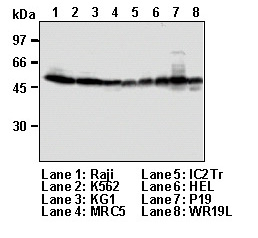Anti-Txnip (VDUP1) (Human) mAb
| Code | Size | Price |
|---|
| MBL-K0205-3 | 100 ug | £361.00 |
Quantity:
Prices exclude any Taxes / VAT
Overview
Host Type: Mouse
Antibody Isotype: IgG1
Antibody Clonality: Monoclonal
Antibody Clone: JY2
Regulatory Status: RUO
Target Species:
- Human
- Mouse
- Rat
Applications:
- Immunohistochemistry (IHC)
- Immunoprecipitation (IP)
- Western Blot (WB)
Shipping:
4°C
Storage:
-20°C
Images
Documents
Further Information
Applications:
WB - 1 ug/mL (chemiluminescence detection system) IP - 2 ug /200 uL of cell extract from 5x10^6 cells IHC - It is reported that clone JY2 can be used in Immunohistochemistry in the reference number 1).
Background:
Thioredoxin (TRX)-binding protein (Txnip), also called Vitamin D3 up-regulated protein 1 (VDUP1) is an endogenous inhibitor of TRX. Redox-dependent regulation of Txnip by mitogenic factors through Reactive oxygen species (ROS) and the specific binding of Txnip to the redox-sensitive cysteine-sulfide center of TRX modulate intracellular levels of ROS and the mitogenic activity of TRX. It has been reported that Txnip plays important roles in diverse cellular processes, including the regulation of cellular redox balance, apoptosis, proliferation, and differentiation.
Concentration:
1 mg/mL
Formulation:
100 ug IgG in 100 ul volume of PBS containing 50% glycerol, pH 7.2. No preservative is contained.
Gene IDs:
Human: 10628 Mouse: 56338 Rat: 117514
Immunogen Translated:
Recombinant human Txnip/VDUP1
Reactivity:
This antibody reacts with Txnip/VDUP1 (50 kDa) on Western blotting and Immunoprecipitation.
Shelf Life:
1 year
Source:
This antibody was purified from hybridoma (clone JY2) supernatant using protein A agarose. This hybridoma was established by fusion of mouse plasmacytoma cell BIOS/2 with Balb/c mouse splenocyte immunized with human recombinant Txnip/VDUP1.
Target:
VDUP-1/Txnip
References
1)
Saxena, G., et al., J. Biol. Chem. 285, 3997-4005 (2010)
2)
Patwari, P., et al., J. Biol. Chem. 284, 24996-25003 (2009)
3)
Chen, J., et al., Am. J. Physiol. Endocrinol. Metab. 296, E1133-E1139 (2009)
4)
Pang, S-T., et al., J. Mol. Endocrinol. 42, 205-214 (2009)
5)
Chen, J., et al., Diabetes, 57, 938-944 (2008)
6)
Yoshioka, J., et al., Circ. Res., 101, 1328-1338 (2007)
7)
Patwari, P., et al., J. Biol. Chem. 281, 21884-21891 (2006)
8)
Yoshioka, J., et al., Circulation 109, 2581-2586 (2004)
9)
Schulze, P. C., et al., J. Biol. Chem. 279, 30369-30374 (2004)
Clone JY2 is used in the reference number 1)-6).






